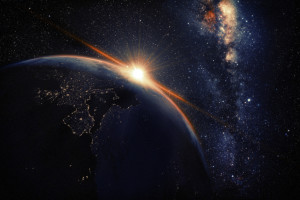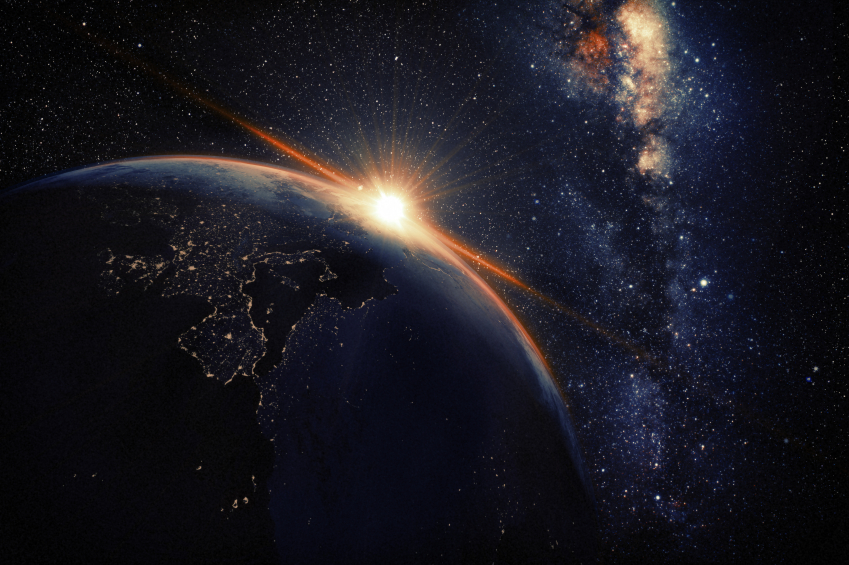 I have written a good bit over the years about what is known as the “Rare Earth” Hypothesis. A recent blog on discovermagazine.com ponders how high the odds are against the existence of another Earth-like planet. More on that in a moment. But first let’s review some of the basics of the Rare Earth Hypothesis.
I have written a good bit over the years about what is known as the “Rare Earth” Hypothesis. A recent blog on discovermagazine.com ponders how high the odds are against the existence of another Earth-like planet. More on that in a moment. But first let’s review some of the basics of the Rare Earth Hypothesis.
While most people, including most scientists, believe that there may be billions of inhabitable planets out there a capable of sustaining complex life, the Rare Earth Hypothesis suggests that such a large number is overstated.
This is because there are not just a few things that come together to support life here on Earth, there are many. Here are some:
- Earth is at just the right distance from the Sun so that water is warm enough to melt, but not so hot as to boil and steam away into space. Water is also able, in this habitable zone (the so-called “Goldilocks” region), to both evaporate and condense at lower levels in the atmosphere, thus permitting a more even distribution of water, and the cycle of water over dry land known as precipitation.
- For suns to spawn Earth-like planets they must have sufficient “metallicity,” which is necessary for the formation of terrestrials rather than gaseous planets.
- Earth is in a “habitable zone” within the galaxy as well. Closer to the center of galaxies, radiation and the presence of wandering planetoids make life there unlikely.
- Earth exists in a disk-shaped spiral galaxy (the Milky Way) rather than in an elliptical (spheroid) galaxy. Spiral galaxies are thought to be the only type capable of supporting life.
- Earth’s orbit around the sun is an almost perfect circle rather than the more common “eccentric” (elongated) ellipse. Steep elliptical orbits take a planet relatively close to and then relatively far from the sun, with great consequences for warmth and light. Earth’s stable, nearly circular orbit around the sun keeps our distance from it relatively constant, and hence the amount heat and light does not vary tremendously.
- Two nearby “gas giants” (Jupiter and Saturn) attract and catch many wandering asteroids and comets and generally keep them from hitting Earth. The asteroid belts also keep a lot of flying rock in a stable orbit and away from us.
- Our molten core creates a magnetic field that holds the Van Allen radiation belts in place. These belts protect Earth from the most harmful rays of the sun.
- Earth’s volcanism plays a role in generating our atmosphere and in cycling rich minerals widely.
- Our sun is just the right kind of star, putting out a fairly steady amount of energy. Other types of stars are more variable in their output and this variance can utterly destroy life or cause it to be unsustainable due to the extremes caused.
- Earth’s fairly rapid rotation reduces the daily variation in temperature. It also makes photosynthesis viable because there is enough sunlight all over the planet.
- Earth’s axis is tilted just enough relative to its orbital plane to allow seasonal variations that help complex life but not so tilted as to make those variations too extreme.
- Our moon also has a good effect by causing tides that are just strong enough to permit tidal zones (a great breeding ground for diverse life) but not so severe as to destroy life by extreme tides.
There are many more items on the list (see the first video below), but let these suffice. The conditions that come together on this planet such that it is capable of sustaining complex life are complicated, remarkable, and some argue rare in the universe. The ability to support life here is the balance of many fascinating things. We cannot but be amazed at the complexity of life and the intricacies it takes in order for it to flourish here. It would appear that for complex life to be sustained, many factors must come together in just the right way. The sheer number of these factors sharply decreases the number of possible Earth-like planets, despite the many billions of galaxies and stars.
All this background information leads us back to the recent blog at discovermagazine.com: Earth-is-a-1-in-700 quintillion kind of place. (700 quintillion is 7 followed by 20 zeros). The blog references a study by Astrophysicist Erik Zackrisson from Uppsala University in Sweden.
Here are some excerpts:
Zackrisson’s work suggests an alternative to the commonly held assumption that planets similar to Earth must exist, based on the sheer number of planets out there …. Current estimates hold that there are some 100 billion galaxies in the universe containing about 10^18 stars, or a billion trillion …. Probability seems to dictate that Earth-twins are out there somewhere.
But according to Zackrisson … Earth’s existence presents a mild statistical anomaly in the multiplicity of planets …. Most of the worlds predicted … orbit stars with different compositions—an important factor in determining a planet’s characteristics. His research indicates that, from a purely statistical standpoint, Earth perhaps shouldn’t exist …. Researchers are confident in the broader implications of their model: Earth is more than your garden-variety planet.
I write on this topic more in wonder and awe than anything else. There is no necessary requirement of our faith that we must believe ourselves alone in the whole universe. God can, and even might have, created intelligent beings on other planets, beings with whom He interacts and whom He loves.
But neither should we too quickly assume that Earth is not a rare jewel. Statistically, it would seem that there is good evidence that we and Earth are rare jewels. Humble amazement at all that it takes to sustain life on our planet is a proper stance at this stage of the evidence. The more we learn, the more it seems that the convergence of all the factors we enjoy on Earth is rare rather than commonplace. Consider well all that God and nature, sustained by God, have done so that you and I can exist. Be amazed; be very amazed!


What infinite love He has for us to create this beautiful (perfect) world and then when tainted with our sinfulness, He sends His son to redeem us and provide us the path to eternity. What great love!
I read the paper, and I must say that I’m not convinced. There is still too much that we don’t know to be able to do a study like this with any confidence. (To name just one thing, Zacrisson did Monte Carlo simulation of galaxy formation – in other words, he generated random galaxies in a computer rather than observing actual ones.)
And yes, while it’s certainly true that many factors have come together to make the Earth what it is, half the trouble lies in the fact that the factors are not independent! For example, the circularity of the Earth’s orbit is certainly not independent of the existence of large nearby (but not too nearby) gas giants. The Earth’s molten outer core is molten largely because of the Earth’s sheer size, which in turn depends on a host of factors. Statistical analysis of this sort of thing is *hard*, indeed nearly impossible, given the paucity of data we still have. (Though more comes in every day!)
Finally – and this is the rock on which all such studies founder – the assumption is being made that all life elsewhere must be exactly like life as we know it here. We have exactly one data point for living planets, and from one data point no extrapolation can be made. We don’t know that life in general requires liquid water; we only know that life here requires it. And since life here arose on a planet with liquid water, why should it be strange that it requires it?
I’m quite certain that God is creative enough to bring forth life under conditions very different from Earth’s. And I’m almost as certain that the laws of physics and chemistry as we know them would permit it. Given that we know exactly nothing about how life arose on *this* planet, we could stand to be humbler in our estimation of it arising elsewhere. Using our limited imagination as the measure of all things seems, well, limited.
Still and all, the fact that God is quite capable of doing it doesn’t mean that He in fact *has*. Perhaps we are indeed alone. As C. S. Lewis pointed out, it would seem to be of a piece with what we observe of nature in general. We simply do not know.
I am not sure I think the presumption you say the study founders on is an assumption of the Study. That said, any word (and life is a word) requires some definition, some parameters. It is true life elsewhere doesn’t have to exist exactly like here. But words do mean things.
GOD is truly unfathomable, exceeding in wonder and formidably incredible in HIS Wisdom that HE even gave this earth in the power of the devil in spite of what he declared to GOD that he will not serve HIM. What mystery is this that GOD cast the devil to earth HIS profound creation. How are we to understand this in our futile mind? I don’t know, yet what I know is that GOD created man in this arena of struggle that despite of evil we will be able to know, love and serve HIM and HIM alone. YHWH NISSI.
The more I think about it the more firm my conclusion that true Christianity demands that we humans are absolutely unique in the universe. That doesn’t mean that there isn’t life on other planets, although I personally believe this to be very unlikely, but that there isn’t life forms that have reason, intellect and free will like we do. For if that were the case, they too would be made in the image and likeness of God, be loved by God, and are just as likely to have “fallen” like we did. So did the 2nd person of the Trinity also become a Vulcan etc? We believe Jesus Christ took on human flesh and will retain that human flesh, albeit glorified, for ever. Doesn’t make theological sense to me to entertain any idea of him also taking on the flesh of other life forms as well. I personally think we are special and unique. I don’t say that out of pride (for I don’t deserve to exist) but out of gratitude that I should have received such a blessing!